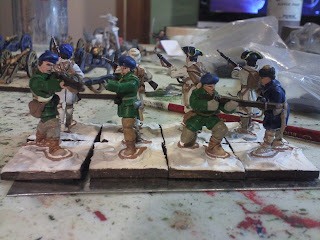Yesterday was the eleventh installment of Dave's Annual Naval Game or DANG, and I was once again in attendance. Unfortunately, my camera was not, so I strongly urge you to take a look at whatever pictures Dave uploads to his blog, the excellent Naval Gazing in my featured blogs list.
This year all the Civil War naval gamers have rallied around the release of Sail and Steam Navies, so it was only fitting that this year's DANG featured a SSN game. Dave created a mini-campaign on a river. Each side had a points limit to choose from and create their riverine flotilla based on the points value of the ships available to them. The Confederates had an iron-clad a-building at the head of the river. The Yankees's job was to brave the obstacles in their path and destroy the ironclad before it became a menace to Union control of the Mississippi.
 |
| Our beloved flagship, the barge, er scow, um ship Tuscumbia. |
I was a Union player and we had to make some decisions about the ships to acquire to dispute the control of western waters with our rebel counterparts. We ultimately decided on the Tuscumbia, an ugly ironclad scow, mounting three of the prettiest 11-inch Dahlgren smoothbores available. We provided the ironclad Essex, timberclad gunboat Lexington, a pair of sternwheel tinclads, and the ram Monarch as escorts. Together with unarmed transports and barges carrying troops and fuel we headed up the mighty Carnot River.
We encountered numerous earthwork gun batteries along the way. But all were dispatched fairly easily, except for the fifth and last one that inflicted a critical hit on the Essex, forcing us to withdraw and make repairs, and leaving us behind schedule.
There were also two surface actions, both occurring at night. The Confederates attacked the anchored Union fleet with three spar torpedo boats. Our deployment was fairly ineffective in terms of offering support so George Kettler quickly found his two tinclads horrifically exposed as the gnat-like Johnnies swept on to the table. Though the tinclads found the range, they couldn't convert their hits into damage, and the Naumkeag was sunk by a spar torpedo. A second torpedo boat seriously damaged the Lexington's paddle wheel forcing us to tow the vessel upstream. The Confederates didn't get off scott free as they mostly expended their supply of spar torpedoes and the Lexington's tormentor managed to blow himself up in the attack.
The second night battle was, of course, the last turn of the campaign. Weathering a host of delays and distractions, the Confederates gave battle before the Yankees reached the ironclad Missouri's birthplace, but just after it had a major engine failure. The pride of the Carnot River Defense Fleet was hauled into action by a tugboat. Alongside the Missouri were the rams Gen. Beauregard and Gen. Bragg, as well as the last armed torpedo boat.
 |
| The General Bragg, captured at Memphis, eventually became the USS General Bragg. |
The Rebs had a bit of an advantage, heading downstream, and we, again were faced with being anchored heading upstream. The Rattler, George's other tinclad, was the first casualty, rammed by the Beauregard. Beauregard and Bragg both took a pounding from the two Union ironclads. Missouri was towed toward the center of the board with it's unpleasant three gun battery. My Monarch was the fastest of the Union vessels, and with no guns to fire, set out to use its chief weapon, its ram, against the slow and unmaneuverable Missouri. Braving two turns of fire, suffering little damage, Monarch skewered Missouri dead amidships, and that was pretty much all she wrote for the southerners. The wooden rams were more or less intact though the torpedo boat was resting comfortably at the bottom of the river.
 |
| A famous engraving of the Monarch ramming the Beauregard. Imagine an almost immobile ironclad gunboat in the place of the Beauregard and that's what happened in our game. Me! Me! I did that! Yes! |
It was a great game and a lot of fun as usual. I was on the winning side, which is rare for me, so that was nice too. Great guys playing as always: David Sullivan, Mark Waddington, Arthur Brookings. Dave Creager, Dale Mickel, Scott Murphy, and George Kettler. Great miniatures from George and David joined my sorry lot (Of course, you can't see them because I'm a dope.) Daveshoe and Lynnshoe provided the eats and took the pics. It was awesome.
This is my third game of Sail and Steam Navies. There are many things I really like about these rules. The firing charts are pretty easy to use, but it is not easy to convert hits to actual damage. In doing this, the creators have really made SSN a rammer's game. With the two movement phases, it's pretty easy for a fast ram to pickle his victim and not even be fired on. I don't think it should be this way. I'm hoping we can maybe make some house rules or get some clarifications that iron out some of these issues.













































